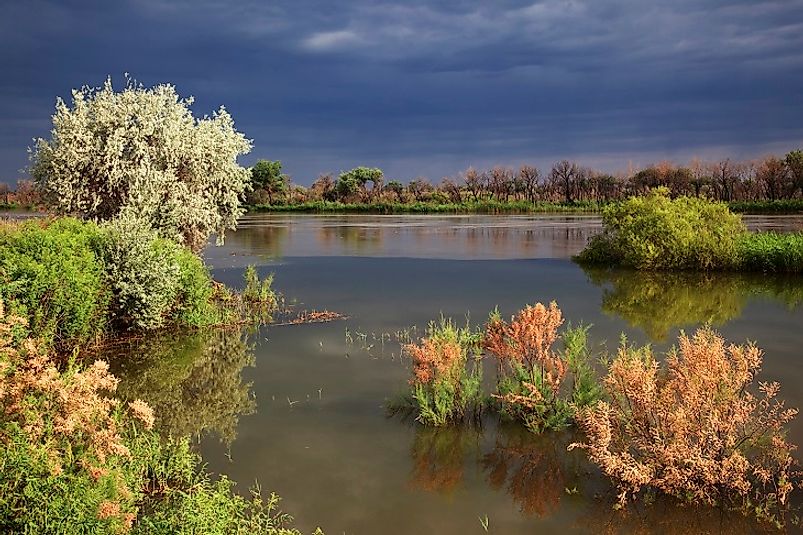The Syr Darya River

5. Description
The Syr Darya River flows for a distance of 2,212 kilometers through the Central Asian countries of Uzbekistan, Tajikistan, and Kazakhstan. It arises at the confluence of the Naryn and Kara Darya (Qoradaryo) rivers in the Fergana Valley in Uzbekistan, and drains into the northern parts of the endorrheic basin of the Aral Sea in Kazakhstan. The Syr Darya basin is estimated to occupy an area of 782,617 square kilometers. Most of the Syr Darya’s tributaries dry up before they reach the river, hence, though the river flows through a long course, its annual flow volume is only 37 cubic kilometers, only half as much as its sister river, the Amu Darya.
4. Historical Role
The Syr Darya is associated with many historical events, especially those involving warfare. The Battle of Jaxartes was fought between Alexander the Great’s army and that of the Scythians at the Syr Darya River in 329 BC, where the latter was completely defeated. Steam navigation started operating in the Syr Darya between 1847 and 1882, fostered by the Russians after the Russian Conquest of Central Asia in the middle of the 19th Century. The Soviet rule in the region witnessed significant improvements in cooperation among the countries sharing the Syr Darya and its natural resources. However, the fall of the Soviet Union led to a cessation of such cooperation, and the river was exploited heavily and impractically, disturbing the hydrology of the river.
3. Modern Significance
The Syr Darya River and its tributaries are highly exploited for irrigation and hydroelectric power generation. The river irrigates vast tracts (approximately 2,000,000 hectares) of some of Central Asia’s most important cotton- and rice-growing lands, and also meets the water demands of cities like Kokand, Turkestan, Khujand, and others. A number of canals and irrigation trenches have been built along the Syr Darya to direct its waters into the agricultural fields lying in its basin. Dams and hydroelectric power stations have been established at various sites along the Syr Darya River and its tributaries. Examples of these hydroelectric projects are Farhod in Uzbekistan, Shardara in Kazakhstan, and Qayroqqum in Tajikistan.
2. Habitat and Biodiversity
Riparian forests with tugay ecosystems cover the landscape along much of the shorelines of the Syr Darya River. A continental climate prevails in the region, with extreme differences in temperatures between the summer and winter seasons. Annual precipitation does not exceed 300 millimeters in most areas. High grasses and woody and shrubby vegetation comprise the riparian forests and tugay areas. Jackals, badgers, forest mice, and Hemprich’s long-eared bats are some of the mammals inhabiting these forests. Various native species of birds, like Scops owls, pheasants, shikra, and kestrels, and migratory birds, like gulls, teals, ducks, and geese, might also be spotted near the Syr Darya’s forested shores. A significant diversity of fishes, amphibians, and reptiles also inhabit the Syr Darya’s aquatic and terrestrial ecosystems.
1. Environmental Threats and Territorial Disputes
Due to the extreme shortage of water in the Syr Darya as a result of excessive water extraction for irrigation, the fish population in the river is experiencing a shocking decline. The fish are now finding it more difficult than ever to produce offspring, as most of the spawning sites have almost completely dried out. The Syr Darya’s water shortage has also adversely affected the water levels of the Aral Sea, which has dropped down to alarmingly low levels as well. There is also a lack of coordinated action among the countries sharing the Syr Dariya’s waters, to save the river. Instead, Uzbekistan, Tajikistan, and Kazakhstan constantly engage in disputes revolving around the sharing of the river and exploiting its resources.











